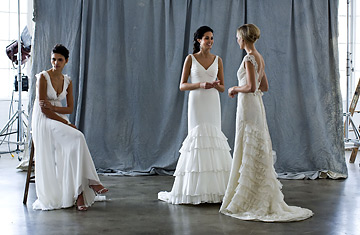
Models on a photo shoot for The Knot wait in a studio.
(2 of 2)
We went public in December 1999. The bubble popped in April 2000. We were losing about $9 million a year and had about $5 million in revenue. Our stock continued to descend, to a low of 26 cents in 2001, and we were making about $24 million in revenue. We were close to being profitable, but when we were delisted, it was one of the darkest times because it's hard to convince the outside world that things are fine when everything around you appears to be falling apart. One thing that precipitated our stock fall was that we bought a company called Wedding Pages, a 12-year-old business based in Omaha, Neb. It was the largest local wedding-magazine publisher, with 52 titles. Our online analysts had seizures when they heard of this purchase. They said, "You're walking around with a $150 million market cap because you're a pure-play dotcom, and you just bought paper — and lots of it." To them it was a disaster. But the company had relationships with 3,000 local wedding vendors. That's incredibly valuable. Today local vendors represent more than 50% of our business. The risks we took paid off. We're one of the few Internet companies that have never bought advertising. We don't do search-engine optimization or buy key words. Despite that, we've managed to touch 80% of the people throwing a wedding in the U.S. today. Our audience turns 100% every year. If we can't build a brand that has its own life, we're not going to have a business.
Once you connect people, wedding planning goes beyond the tactical things needed for the event. There are also emotional issues. We would get a letter every week asking, "Have you ever thought of doing anything for people after the wedding?" So we finally found the time and wherewithal to launch a spinoff brand, the Nest. The reason for this wasn't to build a vehicle to hold on to our audience. It was because people weren't leaving the Knot, and we needed to get them out of the hair of our existing clientele, the brides. The same thing happened with babies. Sixty percent of our audience was having a baby within the first three years of marriage. If you think having newlywed-related content on our bridal boards was a problem, having baby stuff in the newlywed areas was incendiary, because women were like, Look, I'm getting pressure from my mother-in-law — get this baby stuff out of my face.
We have our work cut out for us satisfying our audience in this five-year time frame. We call it the five of firsts. Not only are our consumers going to spend about $70 billion annually on their weddings, but for the first few years of marriage, they will spend in excess of $270 billion buying homes, cars and insurance, merging their finances, preparing for babies and avoiding having babies. People are forming new brand relationships. It seems intuitive, but that's an enormous challenge to communicate to the advertising community because it's not how advertising is bought and sold. But when advertisers get it, it's a wonderful moment. We're seeing groups sprouting up on MySpace and Facebook with people who identify themselves as Knotties or Nesties. The brand is spinning off with the people.